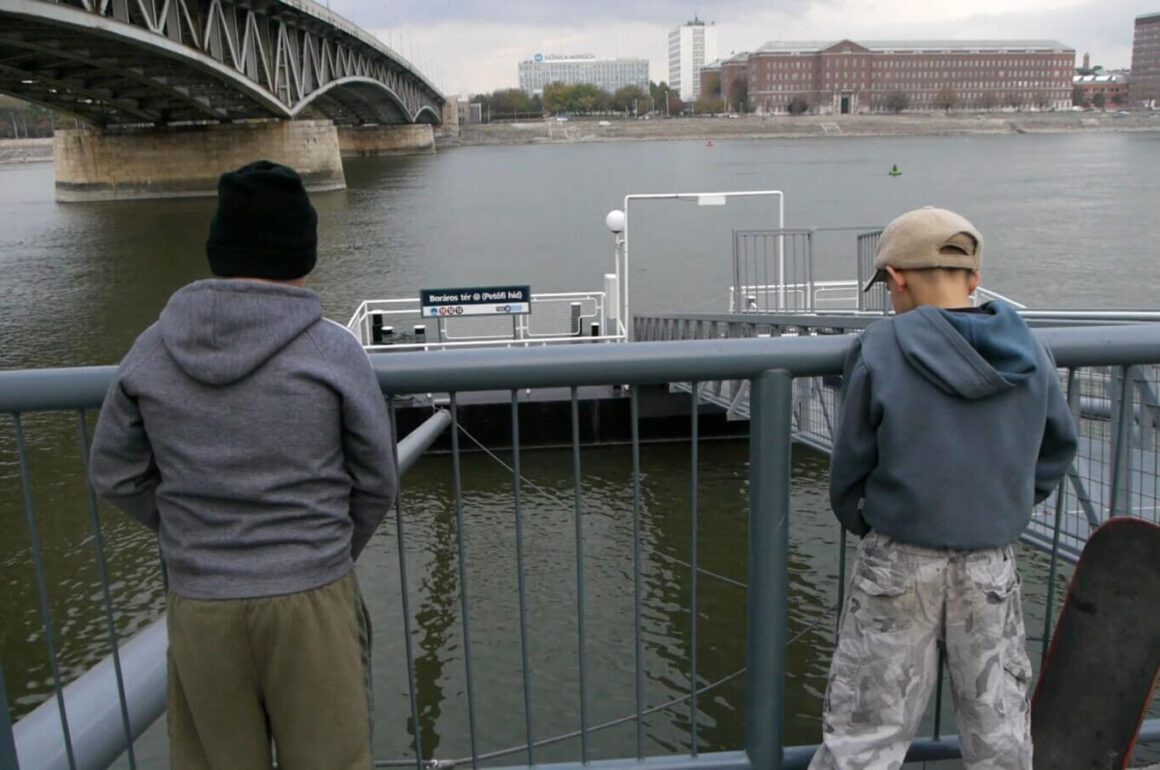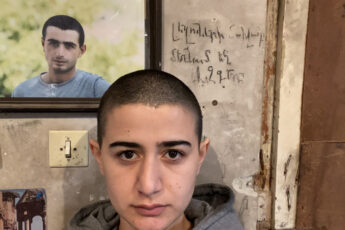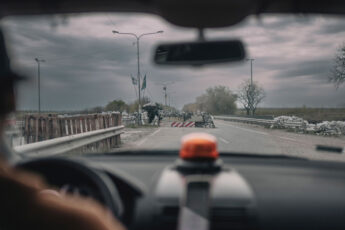Rules of Engagement
Bálint Révész and Dávid Mikulán’s Kix (2024)
Vol. 144 (April 2024) by Konstanty Kuzma
Bálint Révész and Dávid Mikulán’s Kix sets out as any documentary project does: with a search for a motif or protagonist. Only that this search is here acknowledged on screen as the filmmakers roam around Budapest on their skateboards, occasionally stopping to engage a homeless person or elderly pedestrian, who share their views about society and life with the camera. Eventually, the filmmakers cross paths with a group of children who instantly seem ready to interact as they jump on co-director Mikulán’s skateboard, ask for pizza slices, and start spitting amusing insults into the camera. Barely five minutes into the film, the filmmakers have revealed their protagonists – brothers Sanyi and Viktor –, and it does not take long for the audience to realize why the search must end here. Sanyi and Viktor embark on a flurry of mischief, kicking a football at cars and churches; tossing around objects and breaking windows; brawling until they tear up; and flipping off strangers. It is in this youthful appropriation of the cityscape that Sanyi’s and Viktor’s thirst for action, the filmmakers’ skateboarding background, and their cinéma vérité inclinations meet. As in online multiplayer games, where the primary form of interaction with one another is usually virtual violence, through their unruly and destructive behavior, Kix’s protagonists allow the filmmakers to explore their urban surroundings and ultimately get to know Sanyi and Viktor themselves.
Sanyi and Viktor live in a cramped apartment with their parents and grandmother, with all family members sharing a single bed and living space beside their tiny kitchen. Throughout the course of the film, there are intimations of domestic abuse, though their extent is not fully revealed. This is just one reason why the filmmakers find themselves in a difficult position due to their film, which raises moral as well as aesthetic questions. Morally, the film raises the question to what extent it is permissible to be a documentarian in the face of hardship and abuse, especially when one’s primary subjects are children. Aesthetically, the film raises the question to what extent documenting such a reality involves mere observation, and to what extent it involves manipulation. In other words, Kix must be credited with bringing up key issues of documentary filmmaking, specifically those of the permissibility and feasibility of making observational cinema. The commendable premise that the filmmakers appear to be abiding by is that these issues cannot be resolved – certainly not on screen –, and that the filmmakers’ moral choices and aesthetic constraints should therefore simply be recorded.
Over the course of the film, we learn that however lenient the filmmakers may be towards their protagonists’ shenanigans, they are far from being non-interfering. Particularly outrageous ideas, such as swallowing random pills found on the street, running red lights, or swimming in infested-seeming waters, are actively discouraged. Later on, we see the filmmakers hosting the kids for lunch, letting them play computer games at their place, and helping their family with renovations. After Sanyi (the younger brother) asks the filmmakers to spend time with him and Viktor, it becomes clear that the filmmaking process itself is far more than an act of giving a voice to its protagonists. Sanyi and Viktor are seeking companions, friends, fans, mentors, and perhaps even guardians in the filmmakers. Importantly, the filmmakers also include scenes of the mother and even Sanyi asking the filmmakers not to show certain things, and repeated shots of the filmmakers approaching the apartment further remind the audience that they are watching a film.
About mid-way through, the film jumps forward a couple of years to Sanyi’s and Viktor’s teenage years. The jump coincides with several key events, including the birth of cute new sibling Timi, renovation works exacted by the youth welfare office, and Sanyi entering a romantic relationship. Already having gravitated towards Sanyi, the younger and more charismatic of the two brothers, from here on the film focuses on him with the occasional excursus on his surroundings. In one of these, Sanyi’s mother, who had mostly appeared from afar as a ruthless authoritarian in the first half of the movie, gets to tell her part of the story. As it turns out, she is not only solely responsible for housekeeping and raising the kids but has also been the family’s main source of income for nearly two decades, revealing her husband to be a drunkard and good-for-nothing who capitalizes on patriarchal power relations to avoid getting his hands dirty. Sadly, such continuities also relate to Sanyi, who is caught skipping school for a month and begins to consciously develop the macho image that might have been lurking behind his childish misdemeanors already. We see him pumping iron with a cigarette in his mouth to prepare for a ridiculous photo session as his attire becomes ever more bullish. Even the filmmakers appear to lose their inviolability in his eyes, as he lectures them on what questions to ask, or rather, not to ask him.
Despite his best efforts to cultivate this image of manliness, Sanyi’s intelligence and sensitivity shine through, especially in his relationship with his girlfriend, which appears to be dominated by genuine respect and mutual trust (admittedly, the caring aspect appears to be taken more seriously by his girlfriend). Even the muscle-building becomes ever more coherent as we keep being confronted with the violence that Sanyi faces and must defend himself against. Given that this ambivalence and complexity of Sanyi’s existence is revealed without directorial interference, it is particularly irritating that Révész and Mikulán should want to break with their premise of “merely” documenting what the reality is they are facing, and how they as filmmakers relate to it. Over the course of the film, they will begin to make ever stronger creative incursions into the story.
At first, the job of tying all the loose ends together is done by the innocent image of a line of chalk being drawn on the streets of Budapest. Sometimes, the image occurs on its own, at other times, we see Sanyi and Viktor drawing the line at full speed while laying on a skateboard. The image is thus tied back to the project’s skateboarding roots, yet it is also a due expression of Sanyi’s and Viktor’s claiming their urban surroundings, and an act that can credibly be attributed to the youthful protagonists. Soon, though, another element creeps in that breaks with the filmmakers’ observational approach – a reflective voice-over spoken in an altered voice in which Sanyi takes on the role of Batman to verbally claim the streets as a playing field that belongs to everyone. Every time that the directors have Sanyi’s Batman voice resound off-camera to repeat the same childish slogans, the voice-over edges towards becoming a shtick, revealing itself to be an artificial attempt to lend thematic unity to the film through expository monolog. Moreover, the voice-over reinterprets Sanyi’s and Viktor’s anarchistic acts of self-empowerment as mere child-play because it provides them with a conceptual agenda.
A similar issue occurs in the last third of the film, when Sanyi’s and Viktor’s essentially innocent pranks end up causing serious harm. Along with a friend, they set fire to a mattress, which spreads, rather incredibly, to an adjacent dormitory that is burned down to the ground, killing one person. The teenagers (Sanyi and Viktor are 16 and 15 respectively at the time) are arrested and could face lengthy prison sentences, with the sentencing still pending. Rather than trusting in the tested trajectory of their decade-long filmmaking process and documenting the trial, its origins, and its consequences, Révész and Mikulán now turn to interviewing both Sanyi and Viktor and their father to tease out how they feel about the whole situation. Ironically, though the prosecution is trying to frame the youngsters for a crime that they are only indirectly tied to – the real culprits, as the defense attorney rightly stresses, are those who made it possible for a burning mattress on the street to first penetrate the entrance and then spread through the building –, the filmmakers pull attention away from this fact by trying to expose the boys’ introspective thoughts. But uncontextualized and unchallenged, the boys’ self-reproaches and regrets are blatantly inadequate for understanding the case at hand. While it is completely understandable and indeed demanded that the boys feel guilty for what happened, that does not make them guilty – certainly not in the way that the prosecution is suggesting. By abandoning the unreflective portrayal of the boys’ everyday reality post-catastrophe, the film ultimately morphs into a modern iteration of a reductive morality play that reminds viewers of the hope of redemption.
Kix proves that nothing should be as sacred as being true to one’s aesthetic premises. In a cinematic culture dominated by institutional demands and pressures, even those films that – like Kix, perhaps thanks to its guerilla character – develop a cinematic program worth pursuing, tend to be undermined by the insertion of formal and thematic signals that overlay an existing aesthetic product. Introspective dialogs and voice-overs superadded in the name of thematic unity may promise catharsis, but in this case, they gravely downgrade the film’s critical potential, married as it is to documenting the social reality of its protagonist(s). Is it ironic or a trite fact of our times that a film with subversive potential should be crushed by its ultimate adherence to aesthetic conventions?




Leave a Comment